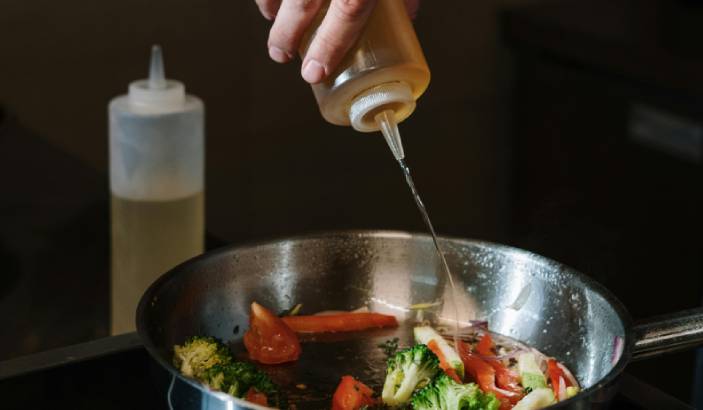Cooking oils are a staple in every kitchen, playing a crucial role in the flavor, texture, and nutritional value of our meals. With a wide variety of oils available, each offering unique benefits and best uses, selecting the right oil can be overwhelming. Whether you’re sautéing vegetables, frying chicken, or dressing a salad, understanding the properties of different cooking oils is essential for both culinary success and maintaining a healthy diet. In this comprehensive guide, we’ll explore the most commonly used cooking oils, detailing their uses, benefits, and smoke points, so you can make informed choices for your cooking needs.
1. Olive Oil
- Types: Extra virgin, virgin, pure, light
- Uses:
- Sautéing and light frying
- Salad dressings and marinades
- Drizzling over cooked dishes and vegetables
- Low to medium-heat cooking
- Benefits:
- Rich in monounsaturated fats, which are heart-healthy
- Contains antioxidants like vitamin E and polyphenols
- Anti-inflammatory properties
- Extra virgin olive oil has a robust flavor, while light olive oil is more neutral
- Smoke Point:
- Extra virgin: 320°F (160°C)
- Virgin: 420°F (215°C)
- Light/Pure: 465°F (240°C)
2. Vegetable Oil
- Composition: Often a blend of soybean, corn, canola, and sunflower oils
- Uses:
- Versatile for frying, baking, and sautéing
- Suitable for making dressings, mayonnaise, and marinades
- Neutral flavor ideal for various cuisines
- Benefits:
- High in polyunsaturated fats
- Affordable and widely available
- Smoke Point: Approximately 400°F to 450°F (205°C to 230°C), depending on the blend
3. Canola Oil
- Uses:
- Baking (cakes, muffins)
- Frying and deep-frying
- Sautéing and stir-frying
- Making salad dressings and sauces
- Benefits:
- Low in saturated fats, making it heart-healthy
- High in omega-3 fatty acids, which are beneficial for brain health
- Mild, neutral flavor
- Smoke Point: 400°F (204°C)
4. Sunflower Oil
- Uses:
- High-heat cooking like frying and roasting
- Baking (cakes, pastries)
- Salad dressings and sauces
- Benefits:
- High in vitamin E, which acts as an antioxidant
- Contains polyunsaturated fats that support heart health
- Light and neutral flavor
- Smoke Point: 440°F (225°C)
5. Coconut Oil
- Types: Virgin (unrefined) and refined
- Uses:
- Baking (cookies, cakes)
- Sautéing and light frying
- Adding flavor to smoothies and coffee
- Used in vegan and paleo recipes
- Benefits:
- High in medium-chain triglycerides (MCTs) that may boost metabolism
- Provides quick energy and may aid in weight loss
- Has antibacterial and antifungal properties
- Smoke Point:
- Virgin: 350°F (177°C)
- Refined: 450°F (232°C)
6. Avocado Oil
- Uses:
- High-heat cooking such as grilling, frying, and roasting
- Salad dressings and marinades
- Drizzling over dishes for a buttery flavor
- Benefits:
- Rich in monounsaturated fats, which are good for heart health
- High in lutein, an antioxidant beneficial for eye health
- High smoke point makes it versatile for various cooking methods
- Smoke Point: 520°F (271°C)
7. Sesame Oil
- Types: Light (untoasted) and dark (toasted)
- Uses:
- Light: Stir-frying, sautéing, and frying
- Dark: Flavoring and finishing dishes, salad dressings
- Commonly used in Asian cuisine
- Benefits:
- Contains antioxidants like sesamol and sesamin
- Rich in polyunsaturated fats
- Distinctive nutty flavor enhances dishes
- Smoke Point:
- Light: 410°F (210°C)
- Dark: 350°F (177°C)
8. Peanut Oil
- Uses:
- Deep-frying (especially in Asian cuisine)
- Stir-frying and grilling
- Roasting vegetables and meats
- Benefits:
- High smoke point makes it ideal for frying
- Mild flavor allows it to blend well with various dishes
- Rich in monounsaturated and polyunsaturated fats
- Smoke Point: 450°F (232°C)
9. Grapeseed Oil
- Uses:
- Sautéing, frying, and stir-frying
- Salad dressings and vinaigrettes
- Baking (as a substitute for butter or other oils)
- Benefits:
- High in polyunsaturated fats, particularly omega-6 fatty acids
- Contains vitamin E, which acts as an antioxidant
- Light, neutral flavor suitable for various dishes
- Smoke Point: 420°F (216°C)
10. Corn Oil
- Uses:
- Deep-frying, sautéing, and roasting
- Baking (bread, muffins)
- Salad dressings and sauces
- Benefits:
- Rich in polyunsaturated fats, including omega-6 fatty acids
- Contains plant sterols that may help reduce cholesterol levels
- Mild, neutral flavor with a high smoke point
- Smoke Point: 450°F (232°C)
11. Palm Oil
- Uses:
- Frying, baking, and sautéing
- Used in processed foods and baked goods
- Suitable for high-heat cooking
- Benefits:
- High in saturated fats, making it stable at high temperatures
- Contains tocotrienols, a form of vitamin E with antioxidant properties
- Long shelf life and resistance to oxidation
- Smoke Point: 450°F (232°C)
12. Soybean Oil
- Uses:
- Frying, sautéing, and baking
- Salad dressings and mayonnaise
- Used in processed foods like margarine
- Benefits:
- High in polyunsaturated fats, including omega-6 and omega-3 fatty acids
- Contains vitamin K, which supports bone health
- Neutral flavor ideal for a variety of dishes
- Smoke Point: 450°F (232°C)
13. Flaxseed Oil
- Uses:
- Salad dressings, drizzling over cooked dishes
- Smoothies and cold dishes
- Not suitable for cooking due to low smoke point
- Benefits:
- Extremely high in omega-3 fatty acids, beneficial for heart health
- Anti-inflammatory properties
- Supports skin health and digestion
- Smoke Point: 225°F (107°C)
14. Walnut Oil
- Uses:
- Salad dressings, drizzling, and finishing dishes
- Adds flavor to baked goods
- Not suitable for high-heat cooking
- Benefits:
- High in omega-3 fatty acids, which support brain health
- Contains antioxidants and polyphenols
- Adds a rich, nutty flavor to dishes
- Smoke Point: 320°F (160°C)
15. Safflower Oil
- Types: High-oleic (monounsaturated) and high-linoleic (polyunsaturated)
- Uses:
- Frying, baking, and sautéing
- Salad dressings and sauces
- High-oleic variety is better for high-heat cooking
- Benefits:
- High in unsaturated fats, particularly linoleic acid
- Neutral flavor makes it versatile for cooking and baking
- High smoke point, especially in the high-oleic variety
- Smoke Point:
- High-oleic: 450°F (232°C)
- High-linoleic: 225°F (107°C)
16. Rice Bran Oil
- Uses:
- Frying, stir-frying, and sautéing
- Salad dressings and marinades
- Suitable for high-heat cooking
- Benefits:
- Contains antioxidants like oryzanol, which may help lower cholesterol
- High in monounsaturated and polyunsaturated fats
- Light flavor with a high smoke point
- Smoke Point: 450°F (232°C)
Choosing the right cooking oil is about more than just flavor—it’s about finding the right balance between taste, health benefits, and cooking techniques. By understanding the unique properties of each oil, from olive to rice bran, you can elevate your culinary creations while supporting your health goals. Whether you’re a seasoned chef or a home cook, this guide provides the knowledge you need to navigate the diverse world of cooking oils, ensuring that every dish you prepare is both delicious and nutritious.









